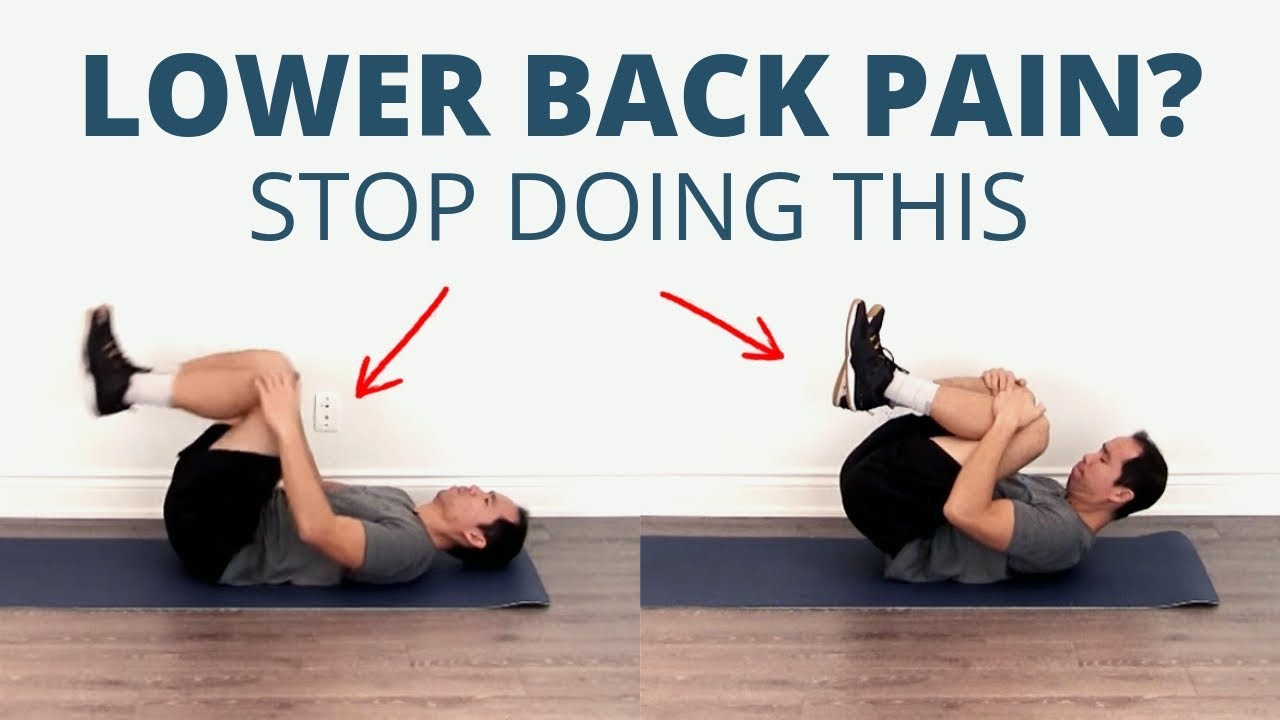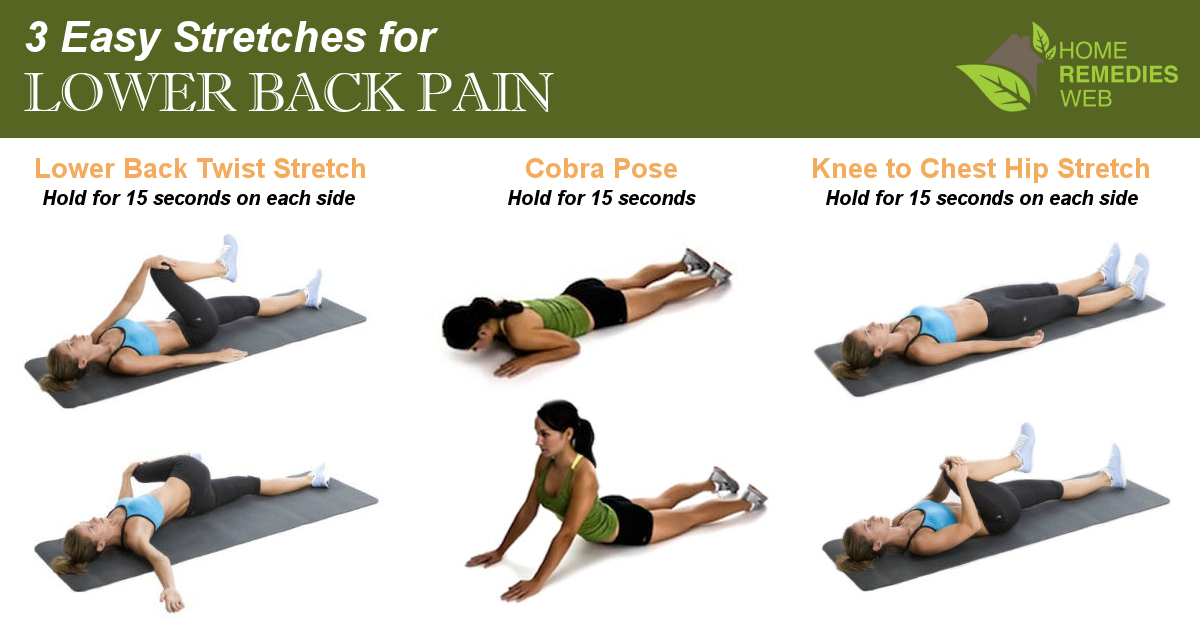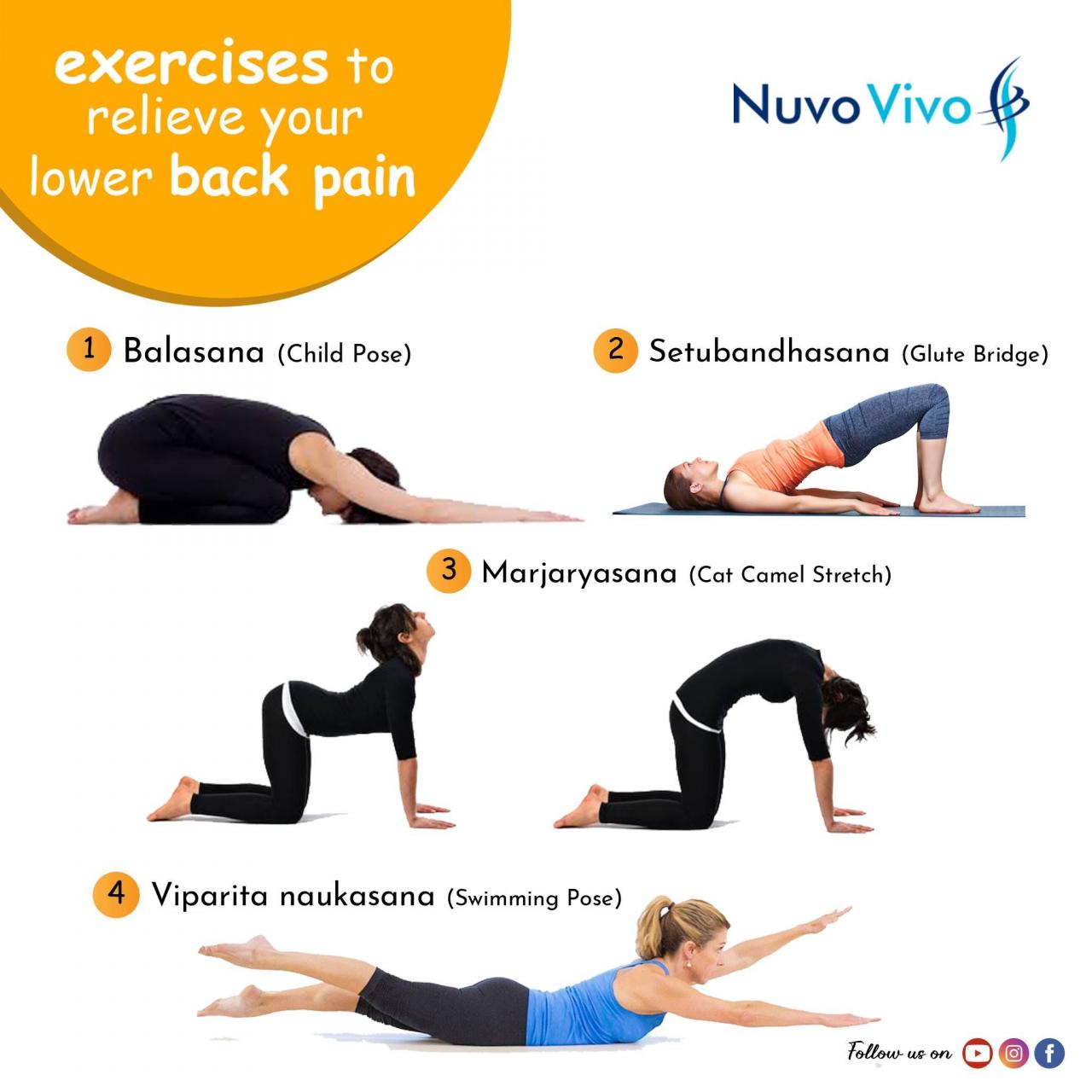
Exercises to relieve lower back pain offer a natural and effective way to alleviate discomfort and improve mobility. This comprehensive guide explores the different types of lower back pain, provides step-by-step instructions for targeted exercises, and discusses the benefits and precautions associated with exercise for back pain management.
Maintaining a healthy posture and strong back muscles is crucial for overall well-being. However, stiffness and tension in these muscles can lead to debilitating back pain .
Understanding the underlying causes of lower back pain is crucial for selecting appropriate exercises. Acute pain, often caused by muscle strain or injury, can benefit from gentle stretching and strengthening exercises. Chronic pain, which persists for more than three months, may require more intensive core-stabilizing exercises and lifestyle modifications.
Types of Lower Back Pain
Lower back pain is a common condition that can affect people of all ages. There are many different types of lower back pain, and the type of pain you experience can vary depending on the underlying cause.
Mother’s Day is a special occasion to celebrate the unwavering love and sacrifices of mothers. Express your heartfelt gratitude with a heartfelt image adorned with warm wishes and adorable Snoopy graphics.
Acute Lower Back Pain
Acute lower back pain is pain that lasts for less than 6 weeks. It is often caused by a sudden injury, such as a fall or a sports injury. Acute lower back pain can also be caused by overuse, such as lifting heavy objects or sitting in an awkward position for a long period of time.
Chronic Lower Back Pain
Chronic lower back pain is pain that lasts for more than 6 weeks. It is often caused by a more serious underlying condition, such as a herniated disc or spinal stenosis. Chronic lower back pain can also be caused by arthritis or other degenerative conditions.
Radicular Pain, Exercises to relieve lower back pain
Radicular pain is pain that radiates down the leg. It is caused by compression of a nerve root in the spine. Radicular pain can be a sign of a more serious underlying condition, such as a herniated disc or spinal stenosis.
Exercises for Relieving Lower Back Pain

There are a variety of exercises that can help relieve lower back pain. These exercises can help to stretch the muscles in the lower back, strengthen the core muscles, and improve posture.
Stretching Exercises
Stretching exercises can help to relieve lower back pain by loosening the muscles in the lower back. Some common stretching exercises for lower back pain include:
- Hamstring stretch
- Quadriceps stretch
- Calf stretch
- Piriformis stretch
- Cat-cow stretch
Strengthening Exercises
Strengthening exercises can help to relieve lower back pain by strengthening the core muscles. The core muscles are the muscles that support the spine and pelvis. Some common strengthening exercises for lower back pain include:
- Plank
- Side plank
- Bird dog
- Superman
- Bridge
Core-Stabilizing Exercises
Core-stabilizing exercises can help to relieve lower back pain by improving posture. Posture is the way you hold your body when you are standing, sitting, or lying down. Poor posture can put strain on the muscles in the lower back, leading to pain.
Some common core-stabilizing exercises for lower back pain include:
- Pelvic tilt
- Dead bug
- Bird dog with reach
- Side plank with leg lift
- Plank with knee drive
Benefits of Exercise for Lower Back Pain: Exercises To Relieve Lower Back Pain

Regular exercise can provide a number of benefits for people with lower back pain. These benefits include:
- Reduced pain
- Improved flexibility
- Increased strength
- Improved posture
- Reduced risk of future episodes of lower back pain
There is a growing body of scientific evidence to support the benefits of exercise for lower back pain. For example, a study published in the journal JAMA Internal Medicine found that people with chronic lower back pain who participated in a 12-week exercise program experienced significant reductions in pain and disability.
Precautions and Contraindications
There are some precautions and contraindications to consider before performing exercises for lower back pain. These include:
- If you have severe lower back pain, it is important to see a doctor before starting an exercise program.
- If you have any other medical conditions, such as heart disease or diabetes, it is important to talk to your doctor before starting an exercise program.
- Some exercises may not be appropriate for people with certain types of lower back pain. For example, people with radicular pain may need to avoid exercises that put pressure on the nerve root.
It is always important to listen to your body and stop if you experience any pain.
Sample Exercise Regimen

The following is a sample exercise regimen for people with lower back pain:| Exercise | Sets | Reps | Duration ||—|—|—|—|| Hamstring stretch | 3 | 10-15 | 30 seconds || Quadriceps stretch | 3 | 10-15 | 30 seconds || Calf stretch | 3 | 10-15 | 30 seconds || Piriformis stretch | 3 | 10-15 | 30 seconds || Cat-cow stretch | 3 | 10-15 | 30 seconds || Plank | 3 | 30-60 seconds | 30 seconds || Side plank | 3 | 30-60 seconds | 30 seconds || Bird dog | 3 | 10-15 | 30 seconds || Superman | 3 | 10-15 | 30 seconds || Bridge | 3 | 10-15 | 30 seconds || Pelvic tilt | 3 | 10-15 | 30 seconds || Dead bug | 3 | 10-15 | 30 seconds || Bird dog with reach | 3 | 10-15 | 30 seconds || Side plank with leg lift | 3 | 10-15 | 30 seconds || Plank with knee drive | 3 | 10-15 | 30 seconds |This is just a sample regimen, and the specific exercises and duration of the regimen may vary depending on your individual needs.
It is important to talk to your doctor or a physical therapist before starting any exercise program.
Fortunately, there are effective lower back exercises that can be performed at home to relieve pain, improve flexibility, and strengthen core muscles.
Tips for Staying Motivated
Staying motivated to exercise can be difficult, especially if you are in pain. Here are a few tips to help you stay motivated:
- Set realistic goals. Don’t try to do too much too soon. Start with a few simple exercises and gradually increase the intensity and duration of your workouts as you get stronger.
- Find an activity that you enjoy. If you don’t enjoy your workout, you are less likely to stick with it. There are many different types of exercises that can help to relieve lower back pain, so find something that you find fun and challenging.
- Make exercise a part of your routine. Schedule time for exercise each day and stick to your schedule as much as possible.
- Find a support system. Exercise with a friend or family member, or join a support group. Having someone to support you can help you stay motivated.
When to Seek Professional Help
If you have lower back pain that is severe or does not improve with home treatment, it is important to see a doctor. Lower back pain can be a sign of a more serious underlying condition, such as a herniated disc or spinal stenosis.Seek
medical attention if you experience any of the following symptoms:
- Pain that is severe or does not improve with home treatment
- Pain that radiates down the leg
- Numbness or weakness in the leg
- Loss of bowel or bladder control
- Fever
- Chills
- Night sweats
Final Wrap-Up

Regular exercise can significantly reduce lower back pain by improving flexibility, strengthening muscles, and correcting posture. However, it’s important to consult a healthcare professional before starting an exercise program to rule out any underlying medical conditions and ensure proper form to avoid further injury.
By following the exercises Artikeld in this guide and adhering to the recommended precautions, individuals can effectively manage their lower back pain, improve their quality of life, and prevent future episodes.
Clarifying Questions
Can exercises worsen lower back pain?
Improper form or exercises that aggravate pain should be avoided. Consulting a healthcare professional or physical therapist is recommended to ensure safe and effective exercise selection.
How often should I exercise for lower back pain?
Start gradually with 15-20 minutes of exercise 2-3 times per week. Gradually increase frequency and duration as pain improves.
What are some exercises to avoid with lower back pain?
Avoid exercises that involve bending forward at the waist, heavy lifting, or high-impact activities that put excessive strain on the lower back.
